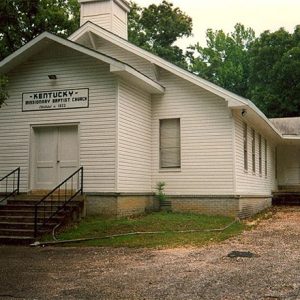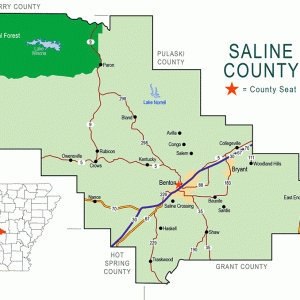calsfoundation@cals.org
Kentucky (Saline County)
The unincorporated community of Kentucky is approximately six miles northwest of Benton (Saline County) within Kentucky Township. Located on Arkansas State Highway 5, Kentucky was the third established community in Saline County following Saline Crossing and Collegeville in the early 1800s. A rural community since its inception, it is centered on Kentucky Baptist Church and the associated cemetery. The church was the first Missionary Baptist church established south of the Arkansas River in Arkansas, and is one of the oldest continuous Baptist church in Arkansas.
In 1815, Caleb Lindsey Sr., Abijah Davis, Levi Spencer, Henry Louis Fletcher, and their respective families left Christian County, Kentucky, for Lawrence County, Arkansas Territory. Around 1824–25, they—along with the families of George James, Samuel Williams, and William Williams—journeyed down the Southwest Trail to Saline County, stopping at Collegeville. Remaining there until they were able to cut a road through the wilderness, they crossed the north fork of the Saline River and settled about a mile farther west, along Williams Creek just north of the Saline River. Located near modern-day Kentucky Baptist Church, the settlement was originally named the Lindsey Community, and later Caldwellton, and then Kentucky.
Under the leadership of John Y. Lindsey, the families began organizing church services that were held within their homes. In 1828, the church was officially recognized in the minutes of the Little Rock Association of Regular Baptists as Kentucky Baptist Church, the name adopted by the settlers, referencing the state of their origin. In 1832, John Y. Lindsey constructed a log church just south of the present cemetery, and he was ordained a deacon in 1834. In 1841, Lindsey was licensed as a Baptist preacher and continued as the church’s pastor until his death in 1866.
Around 1830, Judge Charles Caldwell, a prominent leader in organizing Arkansas for statehood, moved his family to the Lindsey Settlement and built a large mill. The original post office, established in 1831 and known as New Kentucky, moved in 1833 to Caldwell’s home and was renamed Caldwellton. At the establishment of Saline County in 1835, Caldwell unsuccessfully lobbied for the county seat to be located at the Lindsey/Caldwellton location. Due to the central location in the county, and its location on the Southwest Trail, the new town of Benton (Saline County) won out over both Caldwellton and Collegeville. During Arkansas’s quest for statehood, Caldwell ran for and was elected representative from Saline County, resigning some months later to accept appointment as the first circuit judge to the same district.
During the Civil War, both Union and Confederate forces frequented the road between Benton and Hot Springs (Garland County). Both sides made stops at the homes of locals as well as any local mills in operation to obtain forage and supplies. Union forces visited John Lindsey in late 1863 and took over $3,900 worth of cattle, sheep, hogs, corn, and fodder. On December 1, 1863, a small skirmish was fought two miles west of Kentucky between the First Missouri Cavalry (US) and the Third Missouri Cavalry (CS). The Union force was returning to Benton from a patrol when it was ambushed by Confederate forces, losing three killed, two wounded, and one captured; no Confederates casualties were recorded.
Agriculture dominated the efforts of most residents, along with timber and milling, into the twentieth century. Samuel Williams built a water mill on Williams Creek in 1825 to grind meal and saw lumber for the original settlers. In 1848, a man named Jesse James ran a boarding house on the stage route to Hot Springs. In the 1880s, with a growing population, the area became designated as Kentucky Township. Kentucky School was established about the same time and utilized the local church building. Improvements in transportation and the emergence of the aluminum industry in Bauxite (Saline County) and Bryant (Saline County) attracted many to those job opportunities in the 1900s.
A notable activity in the area was the building of Camp Quapaw by the Boy Scouts of America. The Quapaw Council opened the camp in 1925 and located it on the Saline River at Kentucky. It consisted of cabins and a mess hall, and was used extensively by the state’s Boy Scouts. When the U.S. Army Corps of Engineers considered damming the Saline River, a large section of the land would have been flooded. Unsure of the plans, and with the opening of a larger camp, Camp Kiwanis—which eventually became the Gus Blass Scout Reservation—near Damascus (Van Buren and Faulkner counties) in 1976, Camp Quapaw closed and was later sold.
For additional information:
Benton Courier Centennial Edition, 1836–1936. March 25, 1937.
Goodspeed’s Biographies of Saline County, Arkansas. Saline County, Arkansas Genealogy. http://www.argenweb.net/saline/Goodspeed.html (accessed February 1, 2018).
Kentucky Church.” American Baptist Association. http://www.abaptist.org/abaha/arhist/3460792661.pdf (accessed February 1, 2018).
Anthony Rushing
Benton, Arkansas
 Kentucky Church
Kentucky Church  Saline County Map
Saline County Map 




Comments
No comments on this entry yet.